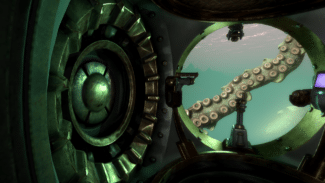A Rogue Escape is admirably committed to both immersion and tough puzzling, making for an experience that will reward those with patience. More in our A Rogue Escape review!
Of all the many dreams I hope VR will one day fulfill for me, I have to admit experiencing the stuffy, cramped confines of a submarine locked in slow, methodical combat wasn’t very high on my list. Hats off to developer Spare Parts Oasis; they did pull off that particularly unpleasant atmosphere very well with A Rogue Escape.
The game — a re-imagining of the developer’s 2019 flatscreen game, Nauticrawl — is short on compromise. It’s a strictly room-scale experience based on physical movement only, so make sure you have a decent-sized play area. It also doesn’t give you too much in the way of direction so, when you come to start up your part-submarine part-Zepplin Frankenmech, you have to do a lot of guess work.
In this way, A Rogue Escape never really holds your hand; it’s a game about figuring out the individual machinations of your monolithic ship, the Nauticrawl, working out the kinks of its leaky, archaic infrastructure and then melding those different elements together at your own pace. Past a discreet set of opening directions, the game isn’t going to tell you how to do anything, so you’ll have to have the patience to figure it out for yourself.
This approach has both pros and cons. A Rogue Escape is a wonderfully immersive experience, with very little to get between you and its claustrophobic world of valves and levers. You watch your sub drag itself through ocean canyons via a radar, alarms indicate when a certain element needs immediate attention, and weapons need to be charged up before firing, draining your battery and costing precious time between attacks. It’s a game of deliberate pace and effort, a bit like doing a one-man performance of The Hunt For Red October (though use the Sean Connery impersonation at your discretion).
Space Parts Oasis often achieves the desired atmosphere, then. It’s just that atmosphere is one of sweaty confusion, panic and frustration. A Rogue Escape moves at a snail’s pace, with controls so cumbersome that you might as well try navigating with your teeth, and paying anything less than 100% attention to its various meters and alarms at all times will land you in hot water. It knows all this and, in murky moments of hopeless anxiety, as enemies fire upon you and you’re not sure where to turn next, it does absolutely nothing to alleviate your concerns. Stuck? Tough luck – figure it out. Thankfully the checkpoints are pretty generous and you can collect items to both repair your hull and restore fuel.
At least it doesn’t overstay its welcome; trust me when I say the 1 – 2 hour runtime feels a lot longer bathed under the red light of the Nauticrawl. And it’s true that, by the time you reach the ending, you’ll genuinely feel like you’ve worked hard to reach something not many others will have endured. Strange as it may seem, there’s power to that.
A Rogue Escape Review – Final Impressions
A Rogue Escape is unapologetically the game it wants to be. It’s a tough, claustrophobic puzzler that rewards those who have the patience to poke and prod their way through its maze of buttons and switches. If its stuffy atmosphere doesn’t sound appealing to you then it’s not likely to win you over, but anyone looking for a more demanding VR puzzle game will no doubt find a lot to like here.
For more on how we arrived at this score, read our review guidelines. What did you make of our A Rogue Escape review? Let us know in the comments below!








